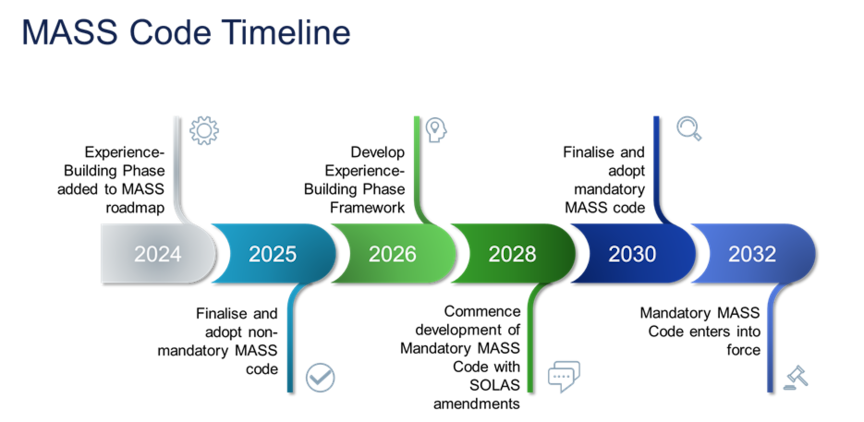Autonomous shipping is currently not fully regulated by IACS or the IMO which means that, currently, it is up to the individual flag states to decide how to regulate this in their own regions. However, the IMO is developing a code for Maritime Autonomous Surface Ships (MASS) which is expected to be ready for voluntary use in 2025. Between 2026 and 2028, a so-called experience-building phase takes place for the development of the Mandatory MASS code, which is expected to start in 2028 and be finalised in 2030. The Mandatory MASS code is expected to enter into force in 2032.

Despite not being fully regulated by IMO, the implementation of technological developments is allowed onboard by following the process stated in IMO MSC.1/Circular.1455 – Guidelines for the Approval of Alternatives and Equivalents. This Circular is used to evaluate concepts and systems of novel technology, including autonomous and remote operations. Some flag states have published documents detailing their approach to autonomous vessels and unmanned ships, such as the Norwegian Maritime Authority, which published the RSV-12-2020 Guidance in connection with the construction or installation of automated functionality aimed at performing unmanned or partially unmanned operations. Our DNV-CG-0264 uses MSC.1/Circular.1455 as a baseline and, in agreement with the Flag States, can be used to evaluate concepts and systems of autonomous vessels. In this process, DNV takes the role of 3 rd party verifier supporting the Flag administrations and the concept submitters (often vessel owners, or vessel operators) to ensure autoremote vessels are as safe as or safer than conventional vessels.
Related links
Digitalization in shipping: Advancements in autonomy and remote operation
Watch the on-demand webinar on advancements in autonomy and remote operation
Ensuring the safety of autonomous shipping
Read our article on the development of the Autonomous and Remotely Operated Ships (AROS) notation for maintaining safety standards.
News
Explore the latest news in Autonomous Shipping
DNV launches class notations for safe development of autonomous shipping technologies
DNV has launched a new family of class notations, Autonomous and Remotely Operated Ships (AROS), providing a framework for how autoremote vessels can achieve equivalent or higher safety compared to conventional vessels.
DNV and Brinav signs MOU further broadening their autonomy collaboration
DNV and Navigation Brilliance (Brinav), signed a memorandum of understanding on autonomous collaboration.
SMM 2024: DNV celebrates advances in ship autonomy
At SMM 2024, DNV celebrated three advances in the ongoing development and deployment of autonomous technologies in shipping.
Approval in Principle for Kongsberg Maritime Chief to Shore
In June 2024, Kongsberg Maritime has received Approval in Principle from classification society DNV to enable a key role to be transferred from a ship to a shore-based control centre.
Remote Operations Centre collaboration
In October 2023, DNV and Samsung Heavy Industries’ signed an MoU for the collaboration to drive innovation and redefine the future of marine transportation.
Related services
Maritime Research on Ship Autonomy
Check out how DNV’s R&D team are working on developing framework and tools for autonomous ship technology assessment.
Maritime Cyber Security
Explore the importance of cyber security for different stakeholders in the maritime industry